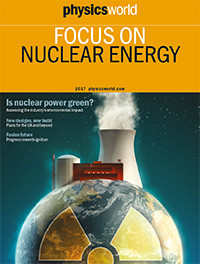 By Margaret Harris
By Margaret Harris
If you’re finding the pace of geopolitical news a bit too rapid at the moment, spare a thought for physicists and engineers working in the nuclear energy sector.
Towards the end of last month, the venerable energy firm Westinghouse Electric issued a press release in which it proudly announced that its AP1000 reactor – a relatively new “passively safe” design in which the reactor core is kept cool without the need for powered pumps or other “active” equipment – had passed a major UK regulatory review. Ordinarily, this would be cause for celebration. The so-called “Generic Design Assessment” process takes years, and completing it helps pave the way for building AP1000s within the UK. An international partnership called NuGen has long hoped to do just that, on a site near Sellafield in north-west England, so in normal times, you might expect it to be celebrating, too.
But these aren’t normal times. Westinghouse’s announcement about the AP1000 came on 30 March, barely 24 hours after the company announced it was filing for bankruptcy. Days later, Westinghouse’s parent firm, Toshiba, was forced to buy the 40% of NuGen that it did not already own, having failed to find a replacement for its one-time partner, ENGIE, after the French utility company pulled out of the project back in February. The latest reports suggest that Toshiba is now on track to post one of the largest annual losses in Japanese corporate history. And as if that wasn’t enough, when the UK government triggered Article 50 in late March, and so began the process of leaving the European Union, it also set the clock ticking on its membership in the European nuclear power organization, Euratom – a departure that will affect fusion projects as well as fission ones.
All of these things happened after the latest Physics World Focus on Nuclear Energy went to press, so I hope you’ll forgive me for not including them in it. What you will find in the focus issue, however, is in-depth coverage of some of the longer-term matters affecting the industry, including safety, reactor design, waste management and environmental concerns.
Highlights in this focus issue include:
How green is nuclear energy? – Policy and technology expert Gail H Marcus assesses the industry’s environmental credentials
Chernobyl’s hidden legacy – Historian Kate Brown argues that scientists should re-examine Soviet-era evidence of health effects from radiation
The long road to ignition – I report on the status of efforts to reach the “break-even” point of inertial confinement fusion at the US National Ignition Facility
Keeping it safe forever – an interview with nuclear-waste management expert Charles McCombie about his career and some of the latest thinking in waste science and technology
Maintaining high standards – Karl Whittle, Mahmoud Mostafavi and Philip D Edmondson explore the materials-science challenges of monitoring nuclear reactor components
All full members of the Institute of Physics received a print edition of the Physics World Focus on Nuclear Energy along with their copy of the April issue of Physics World. However, anyone can read the digital edition of the focus issue free of charge via our apps for iOS, Android and Web browsers.
I hope you find this focus issue interesting, and if you’d like to share your thoughts on it, please get in touch by e-mailing us at pwld@iop.org.
Trackback: The Trenches of the S&T of Nuclear Energy and what it means for emerging regions (such as SEA) – Chronicles of Southeast Asian Nuclear Studies